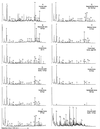Protein preservation and DNA retrieval from ancient tissues
- PMID: 10411891
- PMCID: PMC17532
- DOI: 10.1073/pnas.96.15.8426
Protein preservation and DNA retrieval from ancient tissues
Abstract
The retrieval of DNA from fossils remains controversial. To substantiate claims of DNA recovery, one needs additional information on the preservation of other molecules within the same sample. Flash pyrolysis with GC and MS was used to assess the quality of protein preservation in 11 archaeological and paleontological remains, some of which have yielded ancient DNA sequences authenticated via a number of criteria and some of which have consistently failed to yield any meaningful DNA. Several samples, including the Neanderthal-type specimen from which DNA sequences were recently reported, yielded abundant pyrolysis products assigned to 2,5-diketopiperazines of proline-containing dipeptides. The relative amounts of these products provide a good index of the amount of peptide hydrolysis and DNA preservation. Of these samples, four stem from arctic or subarctic regions, emphasizing the importance of cooler temperatures for the preservation of macromolecules. Flash pyrolysis with GC and MS offers a rapid and effective method for assessing fossils for the possibility of DNA preservation.
Figures

References
-
- Handt O, Höss M, Krings M, Pääbo S. Experientia. 1994;50:524–529. - PubMed
-
- Poinar H N, Höss M, Bada J L, Pääbo S. Science. 1996;272:864–866. - PubMed
-
- Höss M, Vereshchagin M K, Pääbo S. Nature (London) 1994;370:333. - PubMed
-
- Hagelberg E, Thomas M H, Cook C E, Jr, Sher A V, Baryshnikov G F, Lister A M. Nature (London) 1994;370:333–334. - PubMed
Publication types
MeSH terms
Substances
LinkOut - more resources
Full Text Sources
Miscellaneous

